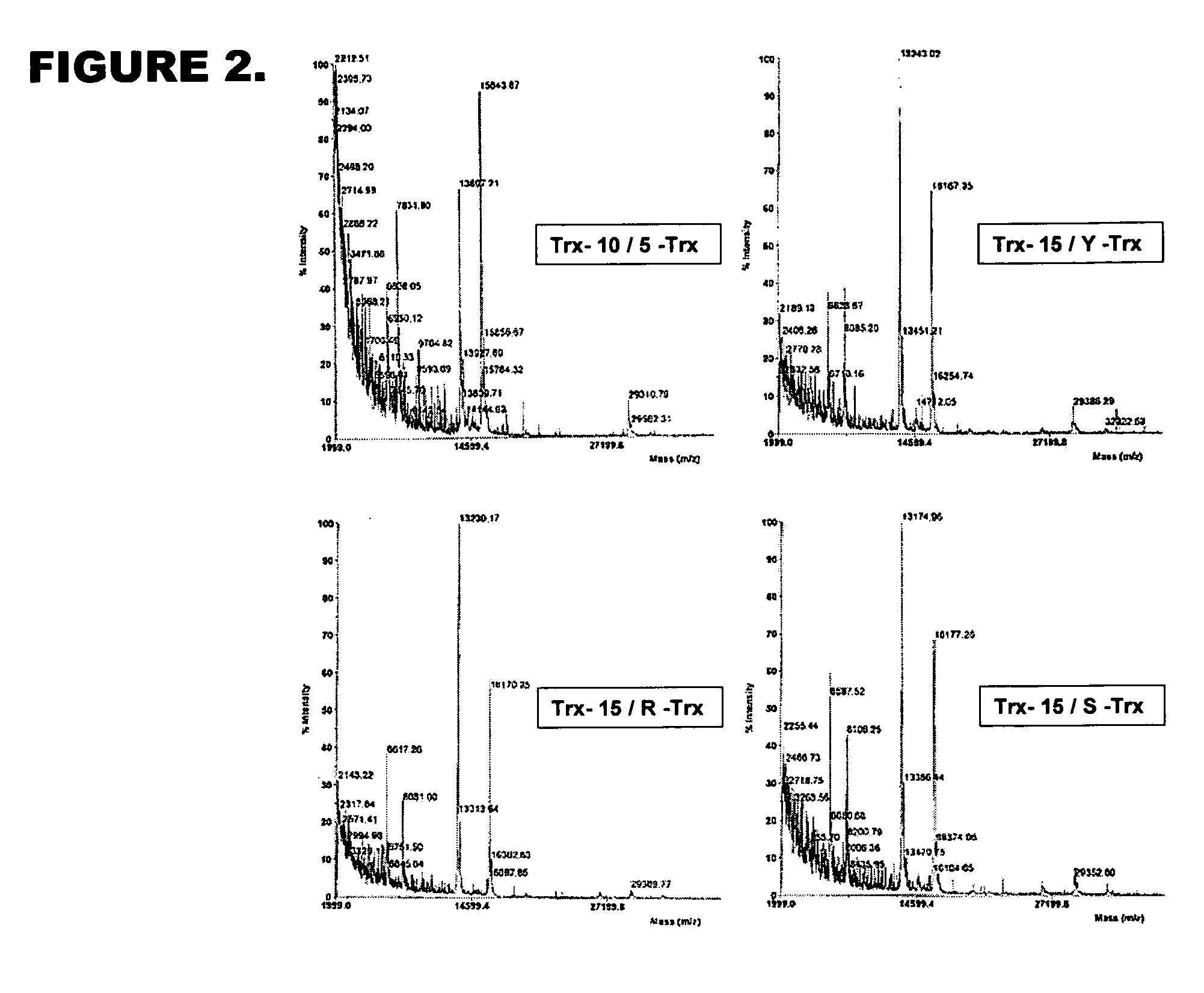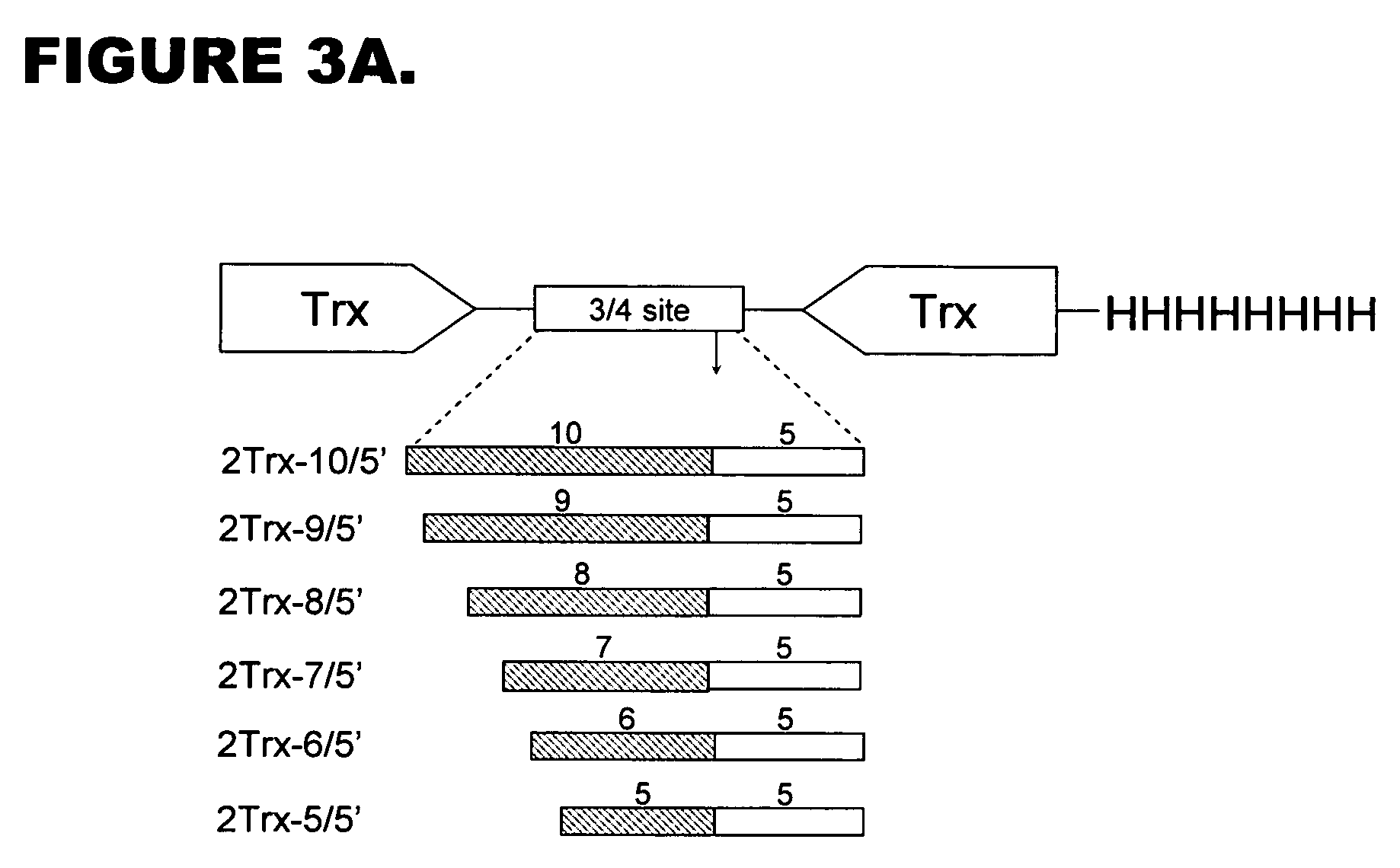Optimized recognition site of the alphavirus non-structural protease for tag removal and specific processing of recombinant proteins
a non-structural protease and recognition site technology, applied in the field of protein detection and purification, can solve the problem that none of the available protease/recognition site-combinations meets all the conditions, and achieves the effect of high efficiency and precise, and easy us
- Summary
- Abstract
- Description
- Claims
- Application Information
AI Technical Summary
Benefits of technology
Problems solved by technology
Method used
Image
Examples
example 1
Construction of Vectors for Expression of Recombinant Proteins in Mammalian Cells
[0081] Vector 1 was designed based on the vector pQM-CMV-E2-N-A-int (Quattromed Ltd. P1-114-020). Full sequence of the vector is shown in FIG. 18. The design of vector 1 is shown in FIG. 16. Full sequence of the This vector was designed so that it allows both precise positioning of the N-terminus of recombinant protein into +1 position of protease cleavage site as well as cloning downstream of the +5 position of modified protease consensus for higher efficiency of the cleavage. Introduction of cleavage site Pdil changes +1 residue in protease recognition site to G, but does not change invariant position of −1. The sequence of the protease recognition site in this vector is thereby according to SEQ ID NO: 5.
[0082] Vector 2 is designed for cloning of recombinant protein expressing gene downstream of optimized 10 / R5 cleavage site for maximally efficient cleavage of recombinant protein. The vector is base...
example 2
[0083] Design of insertion elements which can be used in QM-CMV-E2-N-A-intvector (Quattromed Ltd. Catalog number P1-114-020) based constructs and / or directly inserted into chosen position of recombinant protein using site-specific mutagenesis Cassette designs are based on the use of optimized 1I0 / R5 or 6 / R5 sites (SEQ ID NO: 3 and SEQ ID NO: 4, respectively). These sites can be inserted into expression vector or introduced directly into recombinant protein encoding sequence by site directed mutagenesis:
10 / R55′ GAC GTC CTG CGA CTA GGC CGC GCG GGT GCC CGC ATT TTC TCC TCG 3′3′ CTG CAG GAC GCT GAT CCG GCG CGC CCA CGG GCG TAA AAG AGG AGC 5′ D V L R L G R A G A R I F S S G
[0084] Construct was made by using oligonucleotides:
5′GA TCT GAC GTC CTG CGA CTA GGC CGC GCG GGT GCC CGC ATT TTC TCC TCG GGA TCC A3′A CTG CAG GAC GCT GAT CCG GCG CGC CCA CGG GCG TAA AAG AGG AGC CCT AGG TTC GA
[0085] Oligos were annealed and cloned into the vector pQM-CMV-E2-N-A-int, dige...
example 3
Identification of the Minimal Cleavage Consensus of Pro 39 Using Deletion Mutagenesis
[0094] The analysis of the cleavage consensus requirements was made as a two step experiment. First, the set of constructs, expressing recombinant proteins with truncated protease recognition sites were made. For this purpose the green fluorescent protein was fused with following truncated cleavage consensus elements constructed by PCR:
[0095] 20 / 20 site (control, previously reported to serve as excellent substrate for Pro39), encoding the recognition peptide with SEQ ID NO: 10 as follows:
S G I T F G D F D D V L R L G R A G A ↓ Y I F S S D T G S G H L Q Q K S V R . . . . . . . . . .− 19 −15 −10 −5 −1 +1 +5 +10 +15 +18
[0096] 15 / 20 site (construct 1) encoding the recognition peptide with SEQ ID NO: 11 as follows:
F G D F D D V L R L G R A G A ↓ Y I F S S D T G S G H L Q Q K S V R . . ...
PUM
| Property | Measurement | Unit |
|---|---|---|
| temperatures | aaaaa | aaaaa |
| temperature | aaaaa | aaaaa |
| temperature | aaaaa | aaaaa |
Abstract
Description
Claims
Application Information
 Login to View More
Login to View More - R&D
- Intellectual Property
- Life Sciences
- Materials
- Tech Scout
- Unparalleled Data Quality
- Higher Quality Content
- 60% Fewer Hallucinations
Browse by: Latest US Patents, China's latest patents, Technical Efficacy Thesaurus, Application Domain, Technology Topic, Popular Technical Reports.
© 2025 PatSnap. All rights reserved.Legal|Privacy policy|Modern Slavery Act Transparency Statement|Sitemap|About US| Contact US: help@patsnap.com



